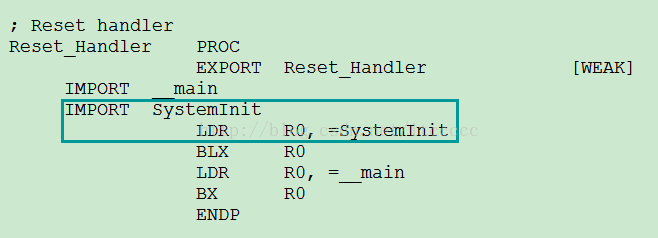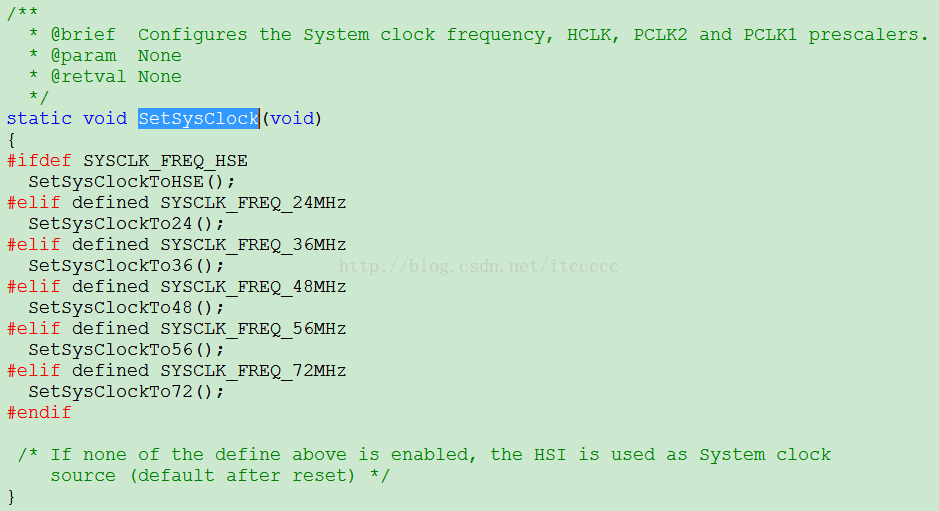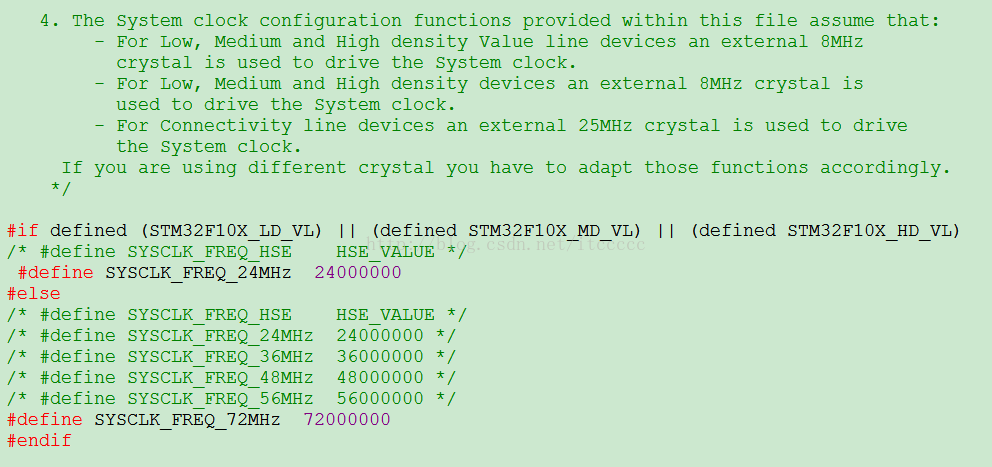STM32系统时钟配置
STM32启动后的第一步对于开发者来说就是系统时钟(RCC)的配置了,STM32系统默认用户外接8M晶振,经过倍频后,系统可以跑到72M。时钟的配置过程或者是初始化过程(当用户不配置时,使用默认外接8M晶振的配置)大体是这样的:
备注: 启动文件:
startup_stm32f10x_cl.s 互联型的器件,STM32F105xx,STM32F107xx
startup_stm32f10x_hd.s 大容量的STM32F101xx,STM32F102xx,STM32F103xx
startup_stm32f10x_hd_vl.s 大容量的STM32F100xx
startup_stm32f10x_ld.s 小容量的STM32F101xx,STM32F102xx,STM32F103xx
startup_stm32f10x_ld_vl.s 小容量的STM32F100xx
startup_stm32f10x_md.s 中容量的STM32F101xx,STM32F102xx,STM32F103xx
startup_stm32f10x_md_vl.s 中容量的STM32F100xx
startup_stm32f10x_xl.s FLASH在512K到1024K字节的STM32F101xx,STM32F102xx,STM32F103xx
产品分类:
- Low-density Value line devices are STM32F100xx microcontrollers where the
Flash memory density ranges between 16 and 32 Kbytes.
- Low-density devices are STM32F101xx, STM32F102xx and STM32F103xx
microcontrollers where the Flash memory density ranges between 16 and 32 Kbytes.
- Medium-density Value line devices are STM32F100xx microcontrollers where
the Flash memory density ranges between 64 and 128 Kbytes.
- Medium-density devices are STM32F101xx, STM32F102xx and STM32F103xx
microcontrollers where the Flash memory density ranges between 64 and 128 Kbytes.
- High-density devices are STM32F101xx and STM32F103xx microcontrollers where
the Flash memory density ranges between 256 and 512 Kbytes.
- XL-density devices are STM32F101xx and STM32F103xx microcontrollers where
the Flash memory density ranges between 512 and 1024 Kbytes.
- Connectivity line devices are STM32F105xx and STM32F107xx microcontrollers.
1、在STM32启动文件startup_stm32f10x_md.s的汇编代码中调用SystemInit()函数,而此函数是在system_stm32f10x.c文件中定义的;
注:如果用keil的启动文件,可能不会调用SystemInit()函数,需要自己在程序中调用。
startup_stm32f10x_md.s:
2、在SystemInit()函数中通过对相关寄存器的一系列配置后,调用了本文件(system_stm32f10x.c)中的SetSysClock()函数
system_stm32f10x.c:
/**
* @brief Setup the microcontroller system
* Initialize the Embedded Flash Interface, the PLL and update the
* SystemCoreClock variable.
* @note This function should be used only after reset.
* @param None
* @retval None
*/
void SystemInit (void)
{
//...省略一部分内容
#if defined (STM32F10X_HD) || (defined STM32F10X_XL) || (defined STM32F10X_HD_VL)
#ifdef DATA_IN_ExtSRAM
SystemInit_ExtMemCtl();
#endif /* DATA_IN_ExtSRAM */
#endif
/* Configure the System clock frequency, HCLK, PCLK2 and PCLK1 prescalers */
/* Configure the Flash Latency cycles and enable prefetch buffer */
SetSysClock();
#ifdef VECT_TAB_SRAM
SCB->VTOR = SRAM_BASE | VECT_TAB_OFFSET; /* Vector Table Relocation in Internal SRAM. */
#else
SCB->VTOR = FLASH_BASE | VECT_TAB_OFFSET; /* Vector Table Relocation in Internal FLASH. */
#endif
}SetSysClock:
在此函数中通过判断之前定义过的宏,来决定调用设置系统不同时钟频率的函数,而这些宏是在此文件前面根据STM32不同的产品来定义的(对于低、中、高密度的产品使用外部8M晶振,对于互联型产品使用外部25M晶振),当然用户可以指定系统运行的速度24M、36M、48M、56M、72M,或自定义HSE_VALUE值,系统默认使用72M;
3、根据第2步所述,系统将在SetSysClock()函数中调用SetSysClockTo72()函数,在SetSysClockTo72()函数中通过一系列对相关寄存器的配置,来完成系统时钟的配置。SetSysClockTo72:
/**
* @brief Sets System clock frequency to 72MHz and configure HCLK, PCLK2
* and PCLK1 prescalers.
* @note This function should be used only after reset.
* @param None
* @retval None
*/
static void SetSysClockTo72(void)
{
__IO uint32_t StartUpCounter = 0, HSEStatus = 0;
/* SYSCLK, HCLK, PCLK2 and PCLK1 configuration ---------------------------*/
/* Enable HSE */
RCC->CR |= ((uint32_t)RCC_CR_HSEON);
/* Wait till HSE is ready and if Time out is reached exit */
do
{
HSEStatus = RCC->CR & RCC_CR_HSERDY;
StartUpCounter++;
} while((HSEStatus == 0) && (StartUpCounter != HSE_STARTUP_TIMEOUT));
if ((RCC->CR & RCC_CR_HSERDY) != RESET)
{
HSEStatus = (uint32_t)0x01;
}
else
{
HSEStatus = (uint32_t)0x00;
}
if (HSEStatus == (uint32_t)0x01)
{
/* Enable Prefetch Buffer */
FLASH->ACR |= FLASH_ACR_PRFTBE;
/* Flash 2 wait state */
FLASH->ACR &= (uint32_t)((uint32_t)~FLASH_ACR_LATENCY);
FLASH->ACR |= (uint32_t)FLASH_ACR_LATENCY_2;
/* HCLK = SYSCLK */
RCC->CFGR |= (uint32_t)RCC_CFGR_HPRE_DIV1;
/* PCLK2 = HCLK */
RCC->CFGR |= (uint32_t)RCC_CFGR_PPRE2_DIV1;
/* PCLK1 = HCLK */
RCC->CFGR |= (uint32_t)RCC_CFGR_PPRE1_DIV2;
#ifdef STM32F10X_CL
/* Configure PLLs ------------------------------------------------------*/
/* PLL2 configuration: PLL2CLK = (HSE / 5) * 8 = 40 MHz */
/* PREDIV1 configuration: PREDIV1CLK = PLL2 / 5 = 8 MHz */
RCC->CFGR2 &= (uint32_t)~(RCC_CFGR2_PREDIV2 | RCC_CFGR2_PLL2MUL |
RCC_CFGR2_PREDIV1 | RCC_CFGR2_PREDIV1SRC);
RCC->CFGR2 |= (uint32_t)(RCC_CFGR2_PREDIV2_DIV5 | RCC_CFGR2_PLL2MUL8 |
RCC_CFGR2_PREDIV1SRC_PLL2 | RCC_CFGR2_PREDIV1_DIV5);
/* Enable PLL2 */
RCC->CR |= RCC_CR_PLL2ON;
/* Wait till PLL2 is ready */
while((RCC->CR & RCC_CR_PLL2RDY) == 0)
{
}
/* PLL configuration: PLLCLK = PREDIV1 * 9 = 72 MHz */
RCC->CFGR &= (uint32_t)~(RCC_CFGR_PLLXTPRE | RCC_CFGR_PLLSRC | RCC_CFGR_PLLMULL);
RCC->CFGR |= (uint32_t)(RCC_CFGR_PLLXTPRE_PREDIV1 | RCC_CFGR_PLLSRC_PREDIV1 |
RCC_CFGR_PLLMULL9);
#else
/* PLL configuration: PLLCLK = HSE * 9 = 72 MHz */
RCC->CFGR &= (uint32_t)((uint32_t)~(RCC_CFGR_PLLSRC | RCC_CFGR_PLLXTPRE |
RCC_CFGR_PLLMULL));
RCC->CFGR |= (uint32_t)(RCC_CFGR_PLLSRC_HSE | RCC_CFGR_PLLMULL9);
#endif /* STM32F10X_CL */
/* Enable PLL */
RCC->CR |= RCC_CR_PLLON;
/* Wait till PLL is ready */
while((RCC->CR & RCC_CR_PLLRDY) == 0)
{
}
/* Select PLL as system clock source */
RCC->CFGR &= (uint32_t)((uint32_t)~(RCC_CFGR_SW));
RCC->CFGR |= (uint32_t)RCC_CFGR_SW_PLL;
/* Wait till PLL is used as system clock source */
while ((RCC->CFGR & (uint32_t)RCC_CFGR_SWS) != (uint32_t)0x08)
{
}
}
else
{ /* If HSE fails to start-up, the application will have wrong clock
configuration. User can add here some code to deal with this error */
}
}备注: 启动文件:
startup_stm32f10x_cl.s 互联型的器件,STM32F105xx,STM32F107xx
startup_stm32f10x_hd.s 大容量的STM32F101xx,STM32F102xx,STM32F103xx
startup_stm32f10x_hd_vl.s 大容量的STM32F100xx
startup_stm32f10x_ld.s 小容量的STM32F101xx,STM32F102xx,STM32F103xx
startup_stm32f10x_ld_vl.s 小容量的STM32F100xx
startup_stm32f10x_md.s 中容量的STM32F101xx,STM32F102xx,STM32F103xx
startup_stm32f10x_md_vl.s 中容量的STM32F100xx
startup_stm32f10x_xl.s FLASH在512K到1024K字节的STM32F101xx,STM32F102xx,STM32F103xx
产品分类:
- Low-density Value line devices are STM32F100xx microcontrollers where the
Flash memory density ranges between 16 and 32 Kbytes.
- Low-density devices are STM32F101xx, STM32F102xx and STM32F103xx
microcontrollers where the Flash memory density ranges between 16 and 32 Kbytes.
- Medium-density Value line devices are STM32F100xx microcontrollers where
the Flash memory density ranges between 64 and 128 Kbytes.
- Medium-density devices are STM32F101xx, STM32F102xx and STM32F103xx
microcontrollers where the Flash memory density ranges between 64 and 128 Kbytes.
- High-density devices are STM32F101xx and STM32F103xx microcontrollers where
the Flash memory density ranges between 256 and 512 Kbytes.
- XL-density devices are STM32F101xx and STM32F103xx microcontrollers where
the Flash memory density ranges between 512 and 1024 Kbytes.
- Connectivity line devices are STM32F105xx and STM32F107xx microcontrollers.


